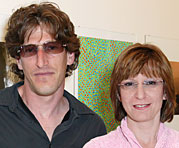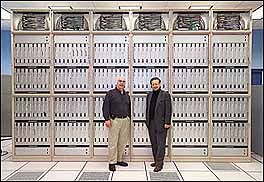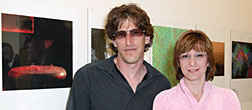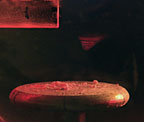| Research
|
Science is boring. Art is stupid. Prove us wrong. Elle Starkman and Andrew Post-Zwicker, of the U.S. Department of Energy's Princeton Plasma Physics Laboratory (PPPL), did just that and came up with art that shows the beauty of science.
Starkman, PPPL's staff photographer, and Post-Zwicker, Head of PPPL's Science Education Program, collaborated to create “Plasma Table,” a photograph of a dust cloud of silica microspheres illuminated by laser light and suspended in a plasma. The dust cloud is approximately 0.5 inches high and floats in a conical shape between the dust tray and an electrode as long as the plasma is maintained. Fundamental dust cloud properties and dynamics have applications ranging from plasma processing to space plasmas. Plasmas are hot, ionized gases. Undergraduate and high school students at PPPL's Science Education Laboratory were studying dusty plasmas in a DC glow discharge when Post-Zwicker asked Starkman to take pictures of the experiment. “We weren't shooting for the beauty of it. We were documenting the science,” Starkman said. Along with the science, however, they saw a breathtaking image. “We spend our time studying the cloud in the dusty plasma experiment for its physical properties and take for granted its intrinsic beauty,” Post-Zwicker said. Starkman used an Olympus digital camera for the complicated task of capturing the shot. The experimental device is tiny and the photo had to be taken inside and in the dark. “All we had was a laser to light it,” she recalled. “The challenge was focusing on it in the dark, which I did manually, and doing a still of the particles suspended in the plasma. We were trying to get the depth of field and bring everything into the image — the electrode and the particles.” Post-Zwicker and Starkman submitted Plasma Table for the Art of Science Competition at Princeton University this spring and took home the first-place prize. More than 200 entries were received. Princeton students and faculty from many departments launched the competition, seeking entries of images that came directly from research in science and engineering or works by artists incorporating tools and concepts from science. “I have always been personally fascinated by the blurring of the boundaries of art and science,” said Post-Zwicker.Submitted by DOE's Princeton Plasma Physics Laboratory |
|||||||||||||||||||||||||||||
|
See Lawrence Livermore's S&TR magazine.
|
Transmission line sensor
|
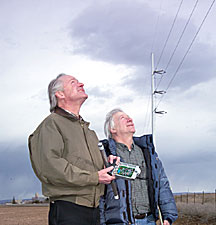 |
|---|
|
INL researchers John Svoboda (left) and Bob Polk
|
High-voltage towers carry millions of watts of power across thousands of miles in the United States, Many of these miles, particularly in the West, track across remote and unpopulated areas – seldom visited and hard to maintain.
Extremes of nature can play havoc on this infrastructure. High winds and ice can bring down lines and disrupt power. But in the last few years, another threat began looming on the horizon for the power industry – terrorism.
DOE Idaho National Laboratory researchers John Svoboda and Bob Polk are developing a platform capable of detecting tower tampering, and relaying this information to the Power Transmission Control Center.
The transmission line sensor is self-powered and virtually maintenance free. The technology consists of a series of small, inexpensive, low-power electronic sensor platforms mounted on conductors adjacent to each tower/pole of an electric power transmission or distribution line.
When an event is recorded by the sensor indicating tower tampering, the platform wakes up and sends a message containing event information and tower identification to adjoining towers. The platforms on the adjoining towers wake up in response and transmit to the next towers. The process continues until the message reaches the end of the line, where it can be communicated to a central monitoring location.
The whole system is powered from the magnetic fields that are produced from the wire's alternating current. The power generated is stored for use by the sensors, processor and RF transmitter/receiver.
While security is the primary driver, the sensors could be capable of detecting other abnormal conditions of concern to utilities such as galloping conductors and fires below the towers.
“There is evidence that the sensors could detect movement of vehicles or even low-flying planes,” said Polk. “Our design using energized systems as the power source, provides space and power for a number of sensors, including miniature acoustic, chemical, biological or nuclear sensors.”Submitted by DOE's Idaho National Laboratory
